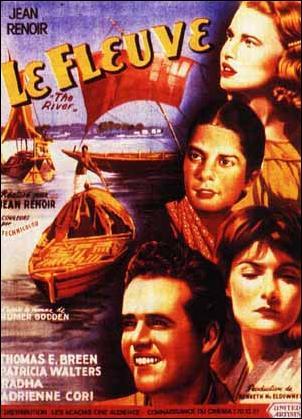“The River” is a weird film. It’s weird for a lot of reasons. It was made in 1951, when experimental films were less familiar. It was made outside of the studio system because the film’s director, Jean Renoir, had fallen out of fashion and couldn’t make the film the way he wanted.

For example, he was unable to cast legendary actor Marlon Brando as Captain John, and cast Thomas Breen in his place. Thomas Breen was not a professional actor, but he did have the advantage of having a wooden leg, just like his character.
“The River” is a story of life in India told from the perspective of British colonialists. The family patriarch manages a jute mill and they all live on a large estate. The estate is fortified so that Indians, aside from the help, are kept out and the white people within live a sheltered existence. Scenes that take place outside of the estate are generally told as documentary footage, viewed from a distance. When the film goes into description of the jute business or a description of life on the Ganges, the jump is actually quite jarring, as the movie moves from storytelling to documentary narrative.
The river is used as a metaphor for life. A river is ever flowing, ever changing, the waters always renewing itself, such is life and death, and if you believe in it, being reborn again.
For the most part, we see the story through the eyes of Harriet, a girl just approaching adolescence. She falls quickly for Captain John and experiences her first love. Captain John, however, is too old for her. He develops a deep affection for her, but not an interest. He is flattered by her attention, but more interested in the more age-appropriate Valerie. In Valerie, a dear friend of Harriet, Harriet experiences her first jealousies, and betrayal. At one point, Valerie reads Harriet’s diary to Captain John, in which Harriet confesses her affections,
“The River” is notable for its accuracy, which is quite amazing for a film made in 1951. At that time, movies were under more pressure to give into stereotypes and superficial cultural depictions. Yet the filmmakers took possibly an unprecedented level of care to get it right.
There are a number of reasons for that. The source material was a book by Rumer Godden, who grew up in India and lived a life that must have parallelled Harriet’s in many ways. Because of the lack of studio funding, there was one financier, Ken McEldowney, a Hollywood florist, who cared very deeply for the project. He talks in depth in audio on Criterion Special Features. Jean Renoir himself, must also have cared very deeply. He is a highly skilled filmmaker, considered one of the best ever. And then there is Satyajit Ray, who was little known at the time but is now considered India’s best filmmaker and acted as Assistant Director on the film.
I look to Indian movies as a way to learn about the history of India. Generally, I’m looking for movies that provide a perspective on the challenges or identity of India. “The River” offers a different viewpoint because it tells us about India from the perspective of British Colonialists. It gives us a view of Indian holidays and philosophy, Diwali and Holi, as they are celebrated in Bengal. And it does little to talk about the social strife the British created. The conflicts and alienation between the Indians and the Englishman are not explored, but are merely a part of the backdrop, they are accepted landscape, as they would be to an adolescent girl growing up in India.
But that’s okay because this is only one viewpoint, it should not be taken alone. “The River” is an honest take, and the families involved here are actually embracing to a certain extent the culture that they are occupying. One of the brilliant inventions of the movie was including the character of Melanie, who is caught between the two cultures, the character who pierces the wall of separation. She is half Indian, half British. Her mother is dead, so she does not have a mother-figure to aid her in her struggles against culture. As a British child she is rejected because she is brown-skinned and looks very Indian. As an Indian she is rejected because she is born without caste. Unfortunately, Renoir did not use a professional actor for this role, and one must forgive the wooden performance.
I would be remiss to not mention the color. This was Jean Renoir’s first technicolor film. Today we take color for granted, but back then it was not only expensive, it was very difficult to work with. Many critics liken the cinematography to the impressionistic paintings of Jean Renoir’s father, Pierre-Auguste Renoir. I think that is unfair because while Jean Renoir probably couldn’t help but be influenced by his father, what he is doing here is no imitation.
It just seems too easy to compare the lush landscapes, and the dances and balls to the paintings of his father, and also unnecessary. India is a land of color. Color is as important to the culture, as it has always been historically to trade. Renoir’s handling of the color is an accomplishment all his own.
He used the great color saturation of technicolor to full effect. The lush green jungles of India provide a splendid backdrop to the many colors of the fabrics people wear. Red is an especially important color in the film. Valerie, Captain John’s love interest, wears red exclusively. And her hair as well is a bright red. And the film climaxes during Holi, the festival of colors, where people throw various color powders on each other.
“The River” is not a movie of action. As Roger Ebert pointed out in his review, the most dramatic incident happens off screen. It is a meditation on the flow of life. There is life, there is death, and the river keeps flowing and renewing itself.
